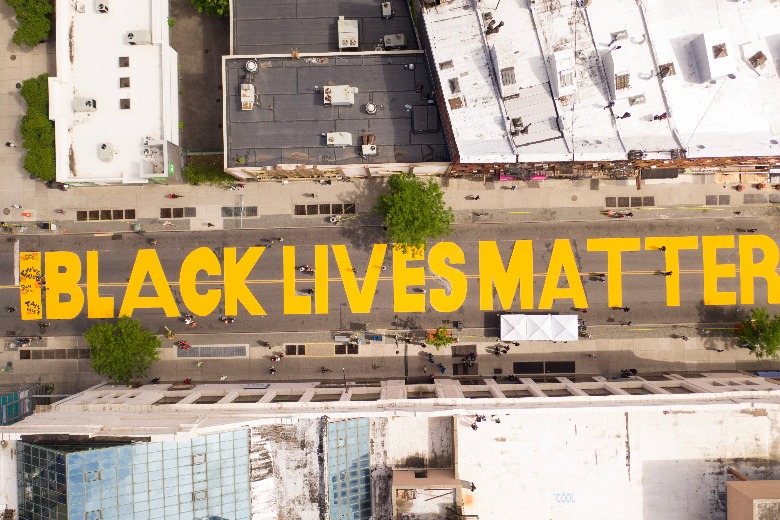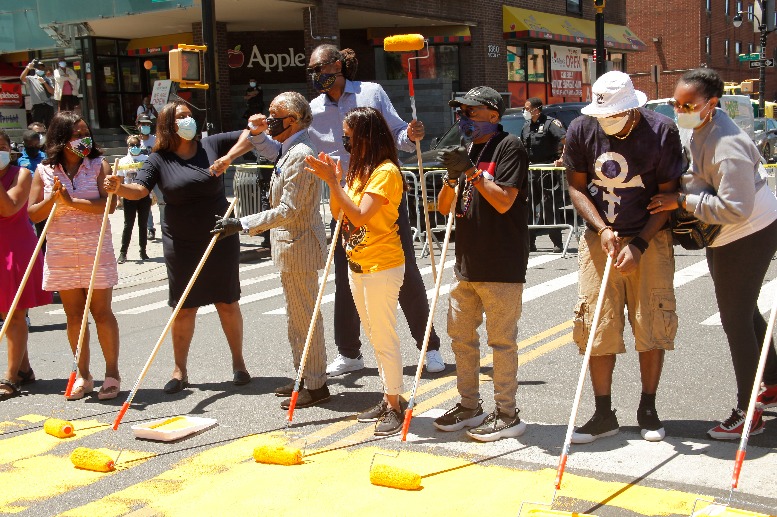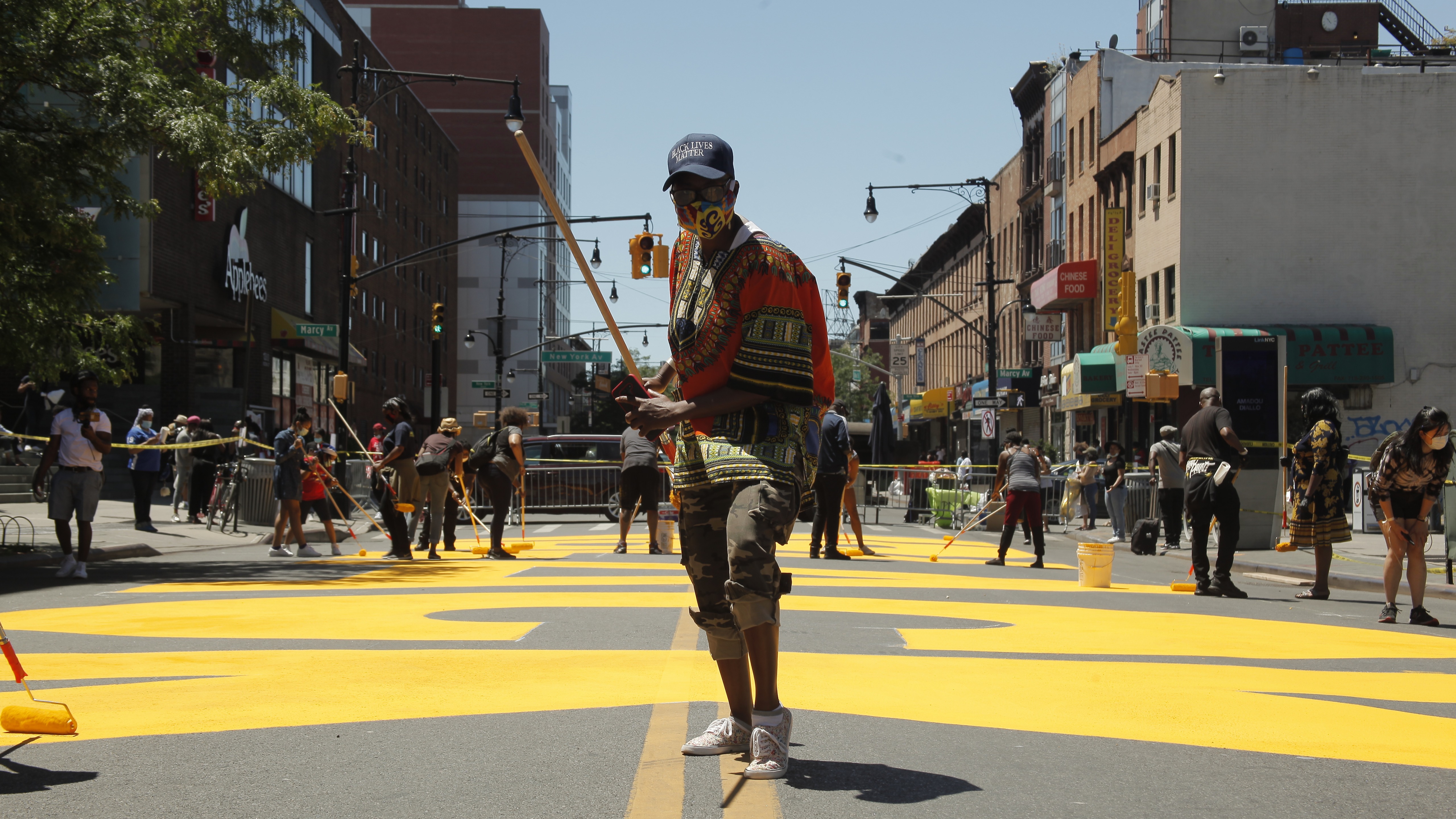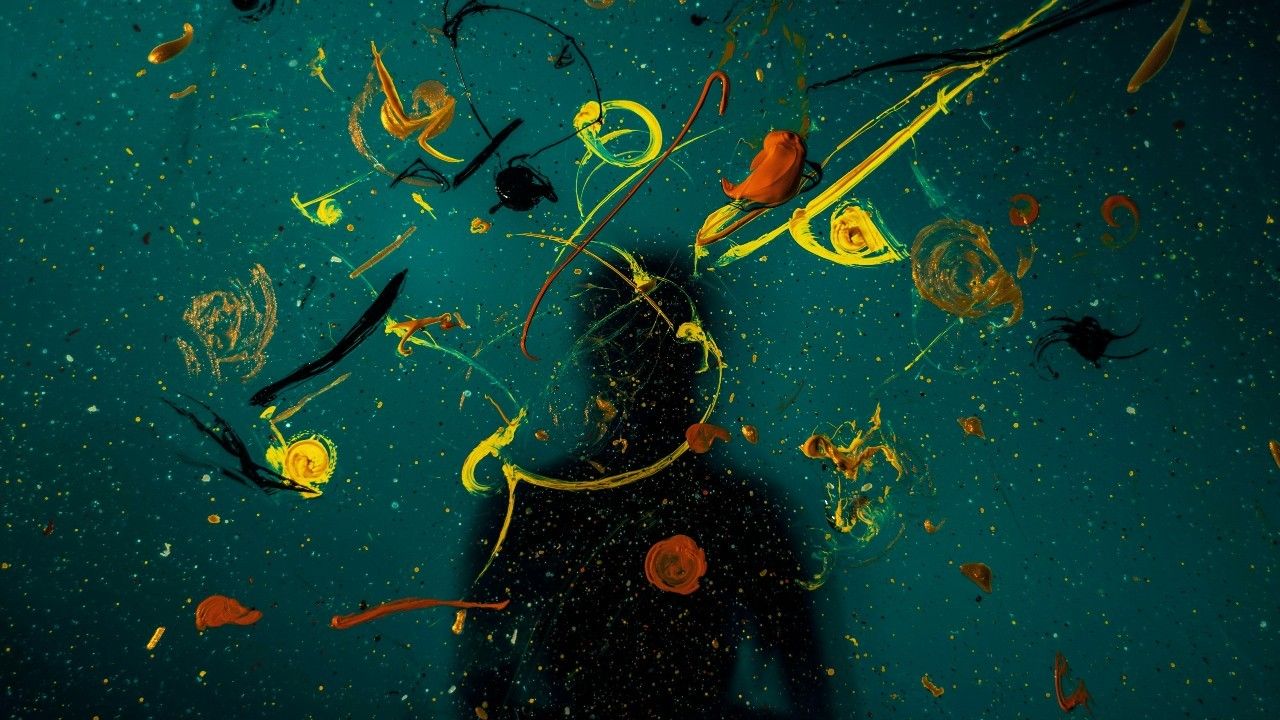The morning of June 13, Lisa Arrindell arrived at Restoration Plaza in Bedford-Stuyvesant to the sight of three words outlined in chalk, stretched 565 feet before her. Alongside over 100 volunteers drawn from the local community, she grabbed a roller and began painting. As she filled in the B, then the L, then the A, then the C, Arrindell was surprised to find herself overwhelmed with tears.
“I realized why I was painting, and I heard in my heart: “We don’t want a mural,” said Arrindell. “I don’t want a mural. I don’t want to say anybody’s name. I would like not to have to paint on the ground that Black Lives Matter.”
The first of its kind painted in New York City, the mural sits central in a historic black neighborhood with a long history of tensions with police, most recently as a hotbed for stop-and-frisk. Its design features 20 yellow bars representing both our current (endless) year, and 20 open caskets. And within the caskets, an ever-growing list of names is added, each a reminder of a life taken by police violence.

Three weeks later, Arrindell returned to the mural to read Frederick Douglass’s historic speech, “What to the Slave Is the Fourth of July?” This live, socially distanced event was organized by the Billie Holiday Theatre, an organization founded in 1972 in the aesthetic and sociocultural kiln of America’s Civil Rights/Black Arts Movements.
Reflecting now on that reading, Arrindell is taken back to her emotions at painting in those first letters. “It did feel appropriate to baptize a work of art with a work of activism, with spoken words by an African American who was formerly enslaved,” said Arrindell. “For, and over, the lives of those who have been lost.”
The July 5th reading of Douglass’s speech was organized by Dr. Indira Etwaroo, executive artistic director of the Billie Holiday. Like all theaters, the Billie Holiday has been closed since March due to the COVID-19 pandemic. The mural now sits right before its locked doors. Seizing on the new outdoor space, Etwaroo has programmed a series of cultural events on the mural, beginning with the reading.
“We want to ensure that our brothers and our sisters are remembered, and Douglass’s speech [reminds us] that the work we continue to do is very much rooted centuries ago,” said Etwaroo. “It’s not just beginning. This has been a long struggle.”
Arrindell read alongside fellow theater veteran Jerome Preston Bates. The two traded off paragraphs of the speech under baking heat for an hour and a half. 20 or so seats were spaced out nearby. The audience was small as the reading began, but grew as passers-by stopped to listen in. Most stood across the street by the plaza, or sat on the sidewalk, clinging to the shade.
Pedestrians lowered their voices as they passed, observing the reading with interest or bafflement. Most of the audience was on Facebook, where the Billie Holiday live-streamed the event.
We want to ensure that our brothers and our sisters are remembered, and Douglass’s speech [reminds us] that the work we continue to do is very much rooted centuries ago. It’s not just beginning. This has been a long struggle.
Both Arrindell and Bates were performing live for the first time since the shutdown had begun.
“The separation of audience is something that we’re getting used to,” said Bates. Despite their distance, he said, “you could feel people leaning in, because it’s so expressive.
“The first 10 pages or so, people were listening – then all of a sudden they began to applaud, almost on every page. They tried to be polite about it, but there were times when they heard something and they had to applaud it.”
Douglass’ speech first praises the signers of the Declaration of Independence as “statesmen, patriots and heroes,” then goes on to elucidate how the promise of the document remains, for slaves and all Black Americans, a pledge unfulfilled. One section reads: “The existence of slavery in this country brands your republicanism as a sham, your humanity as a base pretense, and your Christianity as a lie.”
“Essentially Douglass was asking for the world, the community and the culture to recognize: we are human beings, fully and completely,” said Arrindell. “And that’s what we ask for today, to be seen as human. To be seen the way the dominant culture sees itself.”
“He goes in,” chuckled Bates, who was especially struck by Douglass’s forceful calling out of the clergy’s silence at the time. “He goes in. He was ordained for that moment.”
The speech is typically delivered by a male performer. Etwaroo felt strongly about including a female voice, noting that while the country mourns the death of George Floyd, it still awaits justice for Breonna Taylor.
“It makes sense to me because all of those names [on the mural] came from mothers,” said Arrindell, “Mothers who do want their children’s names on that street. No-one wants to put their children’s name on that street.”
Black Lives Matter murals have faced criticism as a gesture not matched by tangible policy changes, particularly after the City Council’s July 1 budget did not substantially cut NYPD funding. Unlike the mural at Trump Tower, the Brooklyn effort is a local one, spearheaded by council member Robert Cornegy alongside Etwaroo.

Cornegy, who voted “Yes” on the controversial budget, defined the space to Amsterdam News as by and for black New Yorkers.“This wasn’t to validate that statement to other people around the world,” he said. “This is us talking to us for us.”
Etwaroo has since organized distanced film screenings, yoga classes and spoken word performances on the mural. Alongside the cultural events which the closed-street has opened up room for, Etwaroo hopes the community will continue to define the space’s purpose.
“We did not define the space at the Billie Holiday Theatre,” she said. “We simply did what artistic anchors are supposed to do, and that is to remain relevant and resonant to the needs and the conversations that are bubbling up from the community. That is our job. Our job is to listen, to hear, to respond, and to use the art as protest.”
To learn more about the Billie Holiday Theatre and to support their work, click here.
For the full reading of “What to a Slave is the Fourth of July,” written by Frederick Douglass and read by actors Lisa Arrindell and Jerome Preston Bates, watch here.
Author
-

Joey Sims has written at The Brooklyn Rail, Vulture, The Body, Sherwood, Broadway.com, TheaterMania, American Theatre Magazine, Culturebot, Exeunt NYC, New York Theatre Guide, No Proscenium, and is a Senior Critic at Theatrely. He was previously Social Media Editor at Exeunt, and a freelance web producer at TodayTix Group. Joey is an alumnus of the Eugene O’Neill Theater Center’s National Critics Institute. He runs a theater substack called Transitions
View all posts









